Effective Microbial Solutions to Combat Soybean Pests and Diseases
- Biological Control
-
- Commodity name: Effective Microbial Solutions to Combat Soybean Pests and Diseases
Soybean crops are crucial to global agriculture, providing a key source of protein and oil. However, they are vulnerable to a range of pests and diseases that can significantly affect yield and quality. Effective management through integrated approaches ensures healthy plants and optimal production.
Primary Pests and Diseases Threatening Soybean Farming
Soybean farming faces numerous threats from pests and diseases that can drastically impact yield and quality. Key pests include soybean aphids, soybean cyst nematodes, and Japanese beetles, which cause extensive damage to roots, foliage, and pods. Major diseases such as Phytophthora root rot, sudden death syndrome, and white mold can lead to plant decline and reduced production. The economic impact of these threats is substantial, with growers potentially facing severe financial losses due to decreased crop quality and increased management costs. Effective management solutions are thus urgent and crucial to maintaining profitable soybean production.
Latest Technology and Methods for Early Pest and Disease Detection
Advancements in technology have revolutionized early pest and disease detection in soybean fields. Remote sensing technologies, such as drones and satellite imagery, provide real-time monitoring of large areas, allowing for the rapid identification of problem spots. These tools can detect early signs of stress or infection, enabling timely intervention.
Another cutting-edge approach is the use of precision agriculture techniques, which utilize sensors and data analytics to monitor soil health, moisture levels, and plant vitality. By integrating this data, farmers can predict and prevent pest and disease outbreaks more effectively.
Moreover, molecular diagnostic tools like PCR (polymerase chain reaction) and LAMP (loop-mediated isothermal amplification) enable the detection of pathogens at a molecular level before symptoms appear, ensuring early and accurate diagnosis. These technologies, combined with traditional scouting methods, form a comprehensive strategy for managing soybean plant health, reducing the reliance on chemical treatments, and promoting sustainable agricultural practices.
Innovative Biological Control Methods for Sustainable Soybean Management
Biological control is a key component of Integrated Pest Management (IPM) strategies, offering sustainable solutions for managing pests and diseases in soybean fields. IPM combines biological, cultural, mechanical, and chemical methods to maintain pest populations below damaging levels while minimizing environmental impact. Biological control leverages natural predators, parasites, and pathogens to target specific pests, reducing the need for chemical pesticides and promoting ecosystem balance.
In soybean farming, beneficial insects such as lady beetles and parasitic wasps are used to control soybean aphid populations. Nematode-trapping fungi and predatory nematodes can help manage soybean cyst nematode populations. Additionally, introducing beneficial soil microbes can improve plant health and resistance to pathogens like Fusarium and Rhizoctonia.
By integrating these advanced technologies and innovative biological control methods, soybean farmers can effectively manage pest and disease pressures, ensuring sustainable and profitable crop production.
Soybean Pests
Soybean Diseases
Soybean Nutrition
Soybean Pests
Soybean Aphid (Aphis glycines)
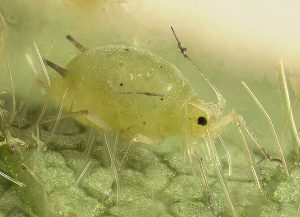
Features:
Soybean Aphids are small, soft-bodied insects that are primarily recognized for their ability to rapidly colonize soybean plants. These pests are significant in soybean fields due to their potential to cause direct damage through feeding and to act as vectors for plant viruses. They are typically light green to pale yellow and measure about 1/16 inch in length. Soybean Aphids have both winged and wingless forms, with the winged ones facilitating the spread between plants and fields.
Symptoms:
The symptoms of Soybean Aphid infestation include yellowing and curling of leaves, stunted plant growth, and the presence of honeydew on leaves and stems, which can lead to the growth of sooty mold. Severe infestations can result in reduced pod set and smaller seed size, directly impacting yield. In addition, aphids can transmit viruses, such as soybean mosaic virus, further compromising plant health and productivity.
Management:
Effective control of Soybean Aphids typically involves regular monitoring and integrated pest management strategies. Scouting fields weekly during the growing season helps in early detection and threshold-based decision-making. Chemical control with insecticides may be necessary when aphid populations exceed economic thresholds, but care should be taken to minimize the impact on beneficial insects. Biological control can be enhanced by encouraging the presence of natural predators, such as lady beetles, lacewings, and parasitic wasps. Cultural practices, including planting resistant soybean varieties and maintaining plant health through proper fertilization and irrigation, can also help mitigate aphid infestations. Additionally, avoiding excessive nitrogen fertilization can reduce aphid attraction to plants.
Solution:
To manage soybean aphid infestations effectively, a combined approach involving biological solutions can be highly effective. Products like Beveria WP offer a sustainable solution. Beveria WP is a biological insecticide derived from the fungus Beauveria bassiana, which specifically targets aphid pests like soybean aphids by infecting them with spores that penetrate their bodies, leading to their death. With a four-hour reentry interval, Beveria WP is safe for both farmers and the environment. By incorporating Beveria WP into an integrated pest management strategy, farmers can significantly reduce soybean aphid populations and protect their crops from extensive damage. Regular application during the early stages of aphid infestation ensures optimal results, promoting healthier and more productive soybean fields.
Soybean Cyst Nematode (Heterodera glycines)
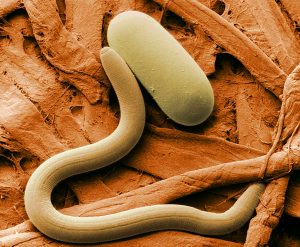
Features:
Soybean Cyst Nematodes (Heterodera glycines) are microscopic roundworms that are primarily recognized for their cyst-forming females, which attach to soybean roots. These pests are significant in soybean fields due to their ability to cause substantial yield losses. The nematodes infect soybean roots, where they establish feeding sites that disrupt nutrient and water uptake, leading to stunted plant growth and reduced yields.
Symptoms:
The symptoms of Soybean Cyst Nematode infestation include stunted plant growth, yellowing of leaves, and reduced root systems with fewer nodules. Infected plants often display uneven growth patterns in fields, with affected areas appearing in patches. Upon closer inspection, tiny white to yellowish cysts, which are the bodies of female nematodes, can be seen on the roots. These cysts turn brown as they mature. Infested plants are more susceptible to drought stress and secondary infections, which further compromise plant health and yield.
Management:
Effective control of Soybean Cyst Nematodes involves a combination of cultural practices, resistant varieties, and crop rotation. Using SCN-resistant soybean varieties is one of the most effective strategies to manage this pest. Rotating soybean with non-host crops, such as corn or small grains, can help reduce nematode populations in the soil. Regular soil testing and nematode sampling are essential for monitoring population levels and making informed management decisions. Additionally, maintaining good soil health through practices like organic matter addition and proper fertilization can enhance plant resilience. In severe cases, the use of nematicides may be considered, but this is often a less preferred option due to cost and environmental concerns. Integrated pest management strategies, combining these methods, are essential for long-term control and mitigation of Soybean Cyst Nematode impact.
Solution:
To manage soybean cyst nematode infestations effectively, a combined approach involving biological solutions can be highly effective. Products like Nema Pro and Nema ProMax from Novobac offer sustainable solutions. These biological nematicides are designed to target soybean cyst nematodes by using natural organisms that disrupt the nematodes’ life cycle, leading to their eventual death. With safe reentry intervals, Nema Pro and Nema ProMax are environmentally friendly and safe for farmers. By incorporating Nema Pro or Nema ProMax into an integrated pest management strategy, farmers can significantly reduce soybean cyst nematode populations and protect their crops from extensive damage. Regular application during the early stages of nematode infestation ensures optimal results, promoting healthier and more productive soybean fields.
Bean Leaf Beetle (Cerotoma trifurcata)
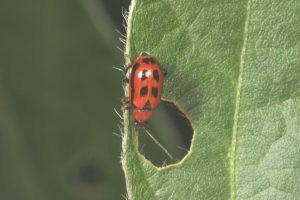
Features:
Bean Leaf Beetles (Cerotoma trifurcata) are small, oval-shaped insects primarily recognized for their distinctive coloration and feeding damage on soybean plants. These pests are significant in soybean fields due to their ability to cause both direct and indirect damage. Adult beetles vary in color from yellow to red and often have four black spots on their wing covers, although some may have no spots. The beetles feed on soybean leaves, stems, and pods, while their larvae feed on roots and root nodules.
Symptoms:
The symptoms of Bean Leaf Beetle infestation include defoliation, which is visible as small, round holes in the leaves. Severe feeding can lead to ragged leaves and reduced photosynthetic ability. Feeding on pods can cause scarring and entry points for secondary pathogens, leading to pod rot and seed damage. The presence of adult beetles can also result in delayed plant growth and reduced vigor, affecting overall plant health and yield. Additionally, Bean Leaf Beetles can transmit bean pod mottle virus, further impacting soybean production.
Management:
Effective control of Bean Leaf Beetles typically involves regular monitoring and integrated pest management practices. Scouting fields early in the growing season and throughout the growing period helps detect beetle presence and assess damage levels. Economic thresholds should guide the application of insecticides, which can be effective but should be used judiciously to minimize impacts on beneficial insects. Cultural practices, such as early planting to ensure plants are more established before beetles become active, can help reduce damage. Crop rotation with non-host plants can also disrupt the life cycle of the beetles. Biological control can be enhanced by encouraging natural predators, such as birds, predatory insects, and parasitoid wasps, which can help manage beetle populations. Integrated pest management strategies that combine these methods are essential for effective and sustainable control of Bean Leaf Beetles.
Solution:
To manage bean leaf beetle infestations effectively, a combined approach involving biological solutions can be highly effective. Products like Beveria WP offer a sustainable solution. Beveria WP is a biological insecticide that utilizes beneficial fungi to specifically target beetle pests like the bean leaf beetle by infecting them with fungal spores that penetrate their bodies, leading to their death. With a four-hour reentry interval, Beveria WP is safe for both farmers and the environment. By incorporating Beveria WP into an integrated pest management strategy, farmers can significantly reduce bean leaf beetle populations and protect their crops from extensive damage. Regular application during the early stages of beetle infestation ensures optimal results, promoting healthier and more productive soybean fields.
Japanese Beetle (Popillia japonica)
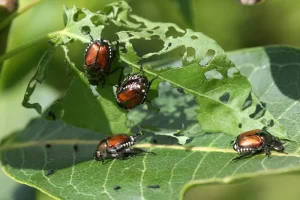
Features:
Japanese Beetles (Popillia japonica) are destructive pests known for their distinctive metallic green bodies and bronze-colored wing covers. These beetles are significant in soybean fields and other crops due to their aggressive feeding behavior. Adult Japanese Beetles feed on the foliage, flowers, and fruits of over 300 different plant species, including soybeans. Their feeding damage can be extensive, leading to substantial yield losses and reduced plant vigor.
Symptoms:
The symptoms of Japanese Beetle infestation include skeletonized leaves, where only the veins remain after the beetles have fed on the leaf tissue. This results in a lace-like appearance and significantly reduces the plant’s photosynthetic ability. In severe infestations, defoliation can be extensive, leading to weakened plants that are more susceptible to environmental stresses and secondary infections. In addition to foliage damage, Japanese Beetles can also feed on soybean pods, causing scarring and potential entry points for diseases.
Management:
Effective control of Japanese Beetles typically involves a combination of cultural, biological, and chemical strategies. Regular monitoring of soybean fields during the beetle’s active period (usually from late June to August) is crucial for early detection and timely management. Scouting should focus on identifying the presence of beetles and assessing the extent of defoliation.
Cultural practices such as crop rotation and maintaining healthy plant stands can help reduce beetle damage. Trap cropping, where more attractive plants are used to lure beetles away from soybeans, can also be an effective strategy. Biological control can be enhanced by encouraging natural predators, such as birds, parasitic wasps, and predatory beetles, which can help manage beetle populations.
Solution:
To manage Japanese beetle infestations effectively, a combined approach involving biological solutions can be highly effective. Products like Myco Pestop offer a sustainable solution. Myco Pestop is a biological insecticide derived from the fungus Metarhizium anisopliae, which specifically targets beetle pests like Japanese beetles by infecting them with spores that penetrate their exoskeletons, leading to their death. With a four-hour reentry interval, Myco Pestop is safe for both farmers and the environment. By incorporating Myco Pestop into an integrated pest management strategy, farmers can significantly reduce Japanese beetle populations and protect their crops from extensive damage. Regular application during the early stages of beetle infestation ensures optimal results, promoting healthier and more productive soybean fields.
Corn Earworm (Helicoverpa zea)
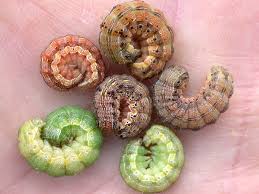
Features:
Corn Earworms (Helicoverpa zea) are significant pests primarily recognized for their larvae, which cause extensive damage to soybean pods. These pests are a major concern in soybean fields due to their feeding habits and ability to reduce yield and crop quality. The larvae are usually green, brown, or pink with alternating light and dark stripes running lengthwise on their bodies. Adult moths are light brown with a wingspan of about 1.5 inches, and they lay eggs on the leaves and pods of soybean plants.
Symptoms:
The symptoms of Corn Earworm infestation include visible feeding damage on soybean pods, where the larvae chew holes and consume developing seeds. This can lead to reduced seed quality and yield losses. The feeding damage often results in pod scarring and can create entry points for secondary pathogens, further compromising plant health. Infested pods may appear deformed and have irregular holes. Heavy infestations can result in significant defoliation, affecting the plant’s overall vigor and productivity.
Management:
Effective control of Corn Earworms involves a combination of monitoring, cultural practices, and chemical control. Regular scouting of soybean fields during the growing season is essential to detect early signs of infestation. Pheromone traps can be used to monitor adult moth populations and help time control measures accurately.
Solution:
To manage corn earworm infestations in soybeans effectively, a combined approach involving biological solutions can be highly effective. Products like Bt Thuricide offer a sustainable solution. Bt Thuricide is a biological insecticide derived from Bacillus thuringiensis that specifically targets caterpillar pests like corn earworms by releasing toxins that disrupt their digestive systems, leading to their death. With a four-hour reentry interval, Bt Thuricide is safe for both farmers and the environment. By incorporating Bt Thuricide into an integrated pest management strategy, farmers can significantly reduce corn earworm populations and protect their soybean crops from extensive damage. Regular application during the early stages of earworm infestation ensures optimal results, promoting healthier and more productive soybean fields.
Green Cloverworm (Hypena scabra)
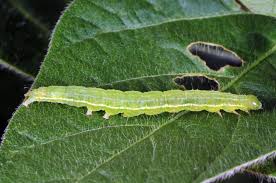
Features:
Green Cloverworms (Hypena scabra) are medium-sized caterpillars known for their light green bodies and three pairs of white stripes running lengthwise. These pests are significant in soybean fields due to their voracious feeding habits, which can lead to substantial defoliation and yield reduction. The larvae are smooth-skinned and slender, growing up to 1 inch in length. Adult moths are brown with a wingspan of about 1.5 inches and are less conspicuous than the larvae.
Symptoms:
The symptoms of Green Cloverworm infestation include noticeable defoliation of soybean plants. The larvae feed primarily on the leaves, creating irregular holes and eventually skeletonizing the foliage if populations are high. This feeding damage can reduce the plant’s photosynthetic capacity, leading to stunted growth and reduced yield. During severe infestations, plants may appear ragged and defoliated, and in extreme cases, larvae can also feed on soybean pods, further impacting seed development and quality.
Management:
Effective control of Green Cloverworms involves regular monitoring and the implementation of integrated pest management practices. Scouting fields frequently during the growing season is crucial for early detection of larvae and assessment of defoliation levels. Economic thresholds should guide the decision to apply insecticides, which can be effective but should be used judiciously to minimize impact on beneficial insects and resistance development.
Solution:
To effectively manage green cloverworm infestations in soybean crops, employing a strategy that includes biological solutions such as Bt Thuricide is highly recommended. Bt Thuricide, a biological insecticide derived from Bacillus thuringiensis, targets larval pests like the green cloverworm. It works by releasing toxins that disrupt the larvae’s digestive systems, causing them to perish shortly after ingestion. This product boasts a four-hour reentry interval, making it safe for farmers and benign to the environment. Incorporating Bt Thuricide into a comprehensive integrated pest management strategy can markedly diminish green cloverworm populations and avert significant crop damage. For best results, it is crucial to apply Bt Thuricide during the initial stages of infestation, which helps maintain healthier and more productive soybean fields.
Cutworms (various species, e.g., Agrotis ipsilon)
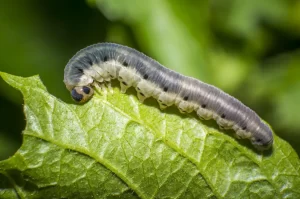
Features:
Cutworms are a group of larval stages of various moth species, including the Black Cutworm (Agrotis ipsilon) and the Variegated Cutworm (Peridroma saucia). These pests are significant in soybean fields due to their feeding habits, which can result in severe damage to seedlings and young plants. Cutworms are usually nocturnal and have smooth, cylindrical bodies that can vary in color from brown to gray. They are typically 1 to 2 inches long when fully grown. The adult moths are less noticeable but are brown or gray with distinctive wing patterns.
Symptoms:
The symptoms of Cutworm infestation include cut or severed stems at or just below the soil surface. Young soybean plants are most vulnerable, and the damage typically occurs at night, leaving plants wilting or lying on the ground by morning. This can lead to significant stand loss and reduced plant density. Cutworms may also feed on the foliage of older plants, causing irregular holes and defoliation, but the most notable damage is the cutting of seedlings, which can lead to substantial replanting costs and delayed crop development.
Management:
Effective control of Cutworms involves a combination of cultural practices, monitoring, and, when necessary, chemical control. Regular scouting of fields, especially during the early growth stages of soybeans, is crucial for early detection of cutworm activity. Inspecting fields for cut or wilted plants and searching for larvae around the base of damaged plants can help identify infestations early.
Solution:
To manage cutworm infestations in soybean crops effectively, a combined approach involving biological solutions can be highly effective. Products like MET Zone offer a sustainable solution. MET Zone is a biological insecticide derived from beneficial fungi that specifically targets caterpillar pests like cutworms by infecting them with fungal spores that disrupt their systems, leading to their death. With a four-hour reentry interval, MET Zone is safe for both farmers and the environment. By incorporating MET Zone into an integrated pest management strategy, farmers can significantly reduce cutworm populations and protect their crops from extensive damage. Regular application during the early stages of cutworm infestation ensures optimal results, promoting healthier and more productive soybean fields.
Twospotted Spider Mite (Tetranychus urticae)
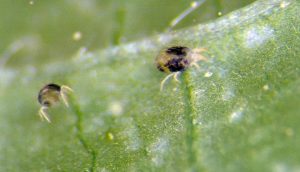
Features:
Twospotted Spider Mites (Tetranychus urticae) are tiny arachnids, typically less than 1 mm in size, recognized for the two distinctive dark spots on their backs. These pests are significant in soybean fields due to their ability to rapidly reproduce and cause extensive damage, especially during hot and dry conditions. They feed by piercing plant cells and sucking out the contents, leading to a reduction in the plant’s photosynthetic ability and overall health.
Symptoms:
The symptoms of Twospotted Spider Mite infestation include stippling or speckling on the leaves, which initially appear as tiny white or yellow spots. As the infestation progresses, leaves may become bronzed, yellowed, and eventually brown and brittle. Severe infestations can lead to premature leaf drop, reduced plant vigor, and decreased yield. The presence of fine webbing on the undersides of leaves is a characteristic sign of spider mite activity. Infested plants are more susceptible to environmental stress and secondary infections.
Management:
Effective control of Twospotted Spider Mites involves a combination of monitoring, cultural practices, and, when necessary, chemical control. Regular scouting of soybean fields, especially during hot and dry periods, is crucial for early detection of mite activity. Scouting should include inspecting the undersides of leaves for mites, stippling, and webbing.
Solution:
To manage twospotted spider mite infestations effectively, a combined approach involving biological solutions can be highly effective. Products like Beveria WP offer a sustainable solution. Beveria WP is a biological insecticide derived from the fungus Beauveria bassiana, which specifically targets pests like twospotted spider mites by infecting them with spores that penetrate their bodies, leading to their death. With a four-hour reentry interval, Beveria WP is safe for both farmers and the environment. By incorporating Beveria WP into an integrated pest management strategy, farmers can significantly reduce twospotted spider mite populations and protect their crops from extensive damage. Regular application during the early stages of mite infestation ensures optimal results, promoting healthier and more productive soybean fields.
Lesser Cornstalk Borer (Elasmopalpus lignosellus)
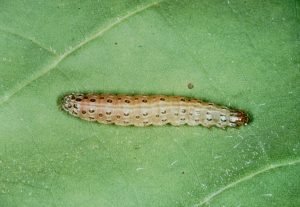
Features:
The Lesser Cornstalk Borer (Elasmopalpus lignosellus) is a significant pest in soybean fields, known for its larvae that burrow into the stems and roots of plants. These pests are particularly troublesome in sandy soils and during dry conditions. The larvae are slender, light brown to greenish-blue with dark bands and spots. Adult moths are small, brown, and inconspicuous, with a wingspan of about 1 inch.
Symptoms:
The symptoms of Lesser Cornstalk Borer infestation include wilting and dying plants, especially in young soybean plants. Larvae create silken tunnels covered with soil particles around the base of the plant. These tunnels can be found just below the soil surface and may extend into the plant stem. Feeding damage results in girdling of the stem, which disrupts the flow of water and nutrients, causing the plants to wilt and die. Infested plants may also exhibit stunted growth, and in severe cases, plant populations can be significantly reduced, impacting overall yield.
Management:
Effective control of Lesser Cornstalk Borer involves a combination of cultural practices, monitoring, and chemical control if necessary. Regular scouting of soybean fields, particularly during the early growth stages and in sandy soils, is crucial for early detection of larvae and damage. Inspecting plants for silken tunnels and larval feeding signs can help identify infestations.
Solution:
To manage Lesser Cornstalk Borer infestations effectively in soybean crops, a combined approach involving biological solutions can be highly effective. Products like Bt Thuricide offer a sustainable solution. Bt Thuricide is a biological insecticide derived from Bacillus thuringiensis that specifically targets caterpillar pests like the Lesser Cornstalk Borer by releasing toxins that disrupt their digestive systems, leading to their death. With a four-hour reentry interval, Bt Thuricide is safe for both farmers and the environment. By incorporating Bt Thuricide into an integrated pest management strategy, farmers can significantly reduce Lesser Cornstalk Borer populations and protect their crops from extensive damage. Regular application during the early stages of borer infestation ensures optimal results, promoting healthier and more productive soybean fields.
Threecornered Alfalfa Hopper (Spissistilus festinus)
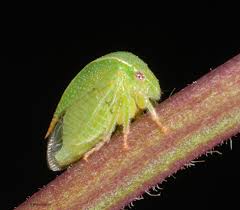
Features:
The Threecornered Alfalfa Hopper (Spissistilus festinus) is a significant pest in soybean fields, recognized for its unique triangular shape and bright green color. These insects are small, about 1/4 inch in length, and have distinctive, wedge-shaped bodies. They primarily feed on the stems of soybean plants, causing direct damage that can lead to significant yield losses. Both adults and nymphs can cause damage by piercing and sucking sap from the plant tissues.
Symptoms:
The symptoms of Threecornered Alfalfa Hopper infestation include girdling of the stems at or near the soil line. This girdling can cause the plants to become weak, leading to lodging and increased susceptibility to secondary infections. Affected plants may exhibit stunted growth, yellowing of leaves, and reduced pod set. The girdled areas on the stems often appear swollen and discolored. In severe infestations, the damage can lead to significant stand reduction and yield losses as plants may die or fail to produce viable pods.
Management:
Effective control of Threecornered Alfalfa Hopper involves regular monitoring, cultural practices, and, if necessary, chemical control. Regular scouting of soybean fields during the growing season is crucial for early detection of hoppers and assessment of stem girdling damage. Monitoring should focus on both adults and nymphs, particularly at the base of plants.
Cultural practices such as maintaining optimal plant density and crop rotation with non-host plants can help reduce the risk of severe infestations. Ensuring good field sanitation by removing crop residues and weeds can minimize overwintering sites for the hoppers. Early planting of soybeans can also help plants outgrow the damage caused by early-season infestations.
Solution:
To effectively manage Threecornered Alfalfa Hopper infestations in soybean crops, utilizing biological solutions like Beauveria bassiana can be highly effective. Beauveria bassiana, a naturally occurring fungus, targets pests such as the Threecornered Alfalfa Hopper by infecting them with spores that invade their bodies, leading to their demise. This biological control method is not only safe for farmers and the environment but also integrates seamlessly into a broader pest management strategy. By regularly applying Beauveria bassiana at the onset of infestation, farmers can significantly curb the population of these pests, safeguarding their soybean crops from significant damage. This approach ensures healthier, more productive soybean fields and promotes sustainable farming practices.
Mexican Bean Beetle (Epilachna varivestis)
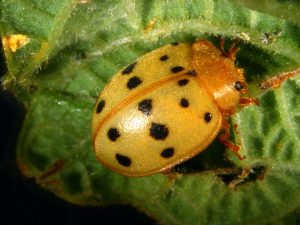
Features:
The Mexican Bean Beetle (Epilachna varivestis) is a significant pest in soybean fields, recognized for its distinctive appearance and extensive feeding damage. Adult beetles are similar in size and shape to lady beetles but are yellow to copper-colored with 16 black spots on their wing covers. The larvae are yellow and spiny, growing up to 1/3 inch long. Both adults and larvae feed on soybean foliage, causing substantial defoliation and potentially severe yield losses.
Symptoms:
The symptoms of Mexican Bean Beetle infestation include skeletonized leaves, where the leaf tissue is eaten between the veins, leaving a lacy or net-like appearance. Severe infestations can result in complete defoliation, leading to reduced photosynthetic capacity and stunted plant growth. This extensive feeding damage can also weaken the plants, making them more susceptible to environmental stresses and secondary infections. In addition to foliage damage, the beetles may feed on pods, affecting seed development and quality.
Management:
Effective control of Mexican Bean Beetles involves regular monitoring, cultural practices, and, if necessary, chemical control. Regular scouting of soybean fields during the growing season is crucial for early detection of beetle activity and assessment of damage levels. Scouting should include inspecting leaves for signs of skeletonization and looking for both adult beetles and larvae.
Cultural practices such as crop rotation with non-host plants can help reduce beetle populations by disrupting their life cycle. Planting early-maturing soybean varieties can also help minimize the period during which beetles can cause significant damage. Maintaining field borders by removing weeds and debris can reduce overwintering sites for the beetles.
Solution:
To manage Mexican bean beetle infestations effectively, a combined approach involving biological solutions can be highly effective. Products like Beveria WP offer a sustainable solution. Beveria WP is a biological insecticide derived from the fungus Beauveria bassiana, which specifically targets beetle pests like Mexican bean beetles by infecting them with spores that penetrate their bodies, leading to their death. With a four-hour reentry interval, Beveria WP is safe for both farmers and the environment. By incorporating Beveria WP into an integrated pest management strategy, farmers can significantly reduce Mexican bean beetle populations and protect their crops from extensive damage. Regular application during the early stages of beetle infestation ensures optimal results, promoting healthier and more productive bean fields.
Soybean Looper (Pseudoplusia includens)
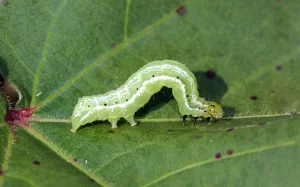
Features:
The Soybean Looper (Pseudoplusia includens) is a significant pest in soybean fields, known for its distinctive looping movement and feeding damage. These caterpillars are green to brown with white stripes running along their sides and can grow up to 1.5 inches long. Adult moths are brown with a wingspan of about 1.5 inches and have a distinctive silver figure-eight marking on their wings. The larvae are the damaging stage, feeding primarily on the leaves of soybean plants.
Symptoms:
The symptoms of Soybean Looper infestation include extensive defoliation, characterized by irregular holes in the leaves and significant leaf tissue loss. This feeding damage reduces the plant’s photosynthetic capacity, leading to stunted growth and lower yield potential. In severe infestations, larvae can consume most of the foliage, leaving only the stems and veins. Such extensive damage can weaken the plants, making them more vulnerable to environmental stresses and secondary infections.
Management:
Effective control of Soybean Loopers involves a combination of regular monitoring, cultural practices, and chemical control when necessary. Regular scouting of soybean fields during the growing season is essential for early detection of looper activity and accurate assessment of defoliation levels. Monitoring should focus on identifying larvae and assessing the extent of leaf damage.
Solution:
To manage soybean looper infestations effectively, a combined approach involving biological solutions can be highly effective. Products like Bt Thuricide offer a sustainable solution. Bt Thuricide is a biological insecticide derived from Bacillus thuringiensis that specifically targets caterpillar pests like soybean loopers by releasing toxins that disrupt their digestive systems, leading to their death. With a four-hour reentry interval, Bt Thuricide is safe for both farmers and the environment. By incorporating Bt Thuricide into an integrated pest management strategy, farmers can significantly reduce soybean looper populations and protect their crops from extensive damage. Regular application during the early stages of looper infestation ensures optimal results, promoting healthier and more productive soybean fields.
Velvetbean Caterpillar (Anticarsia gemmatalis)
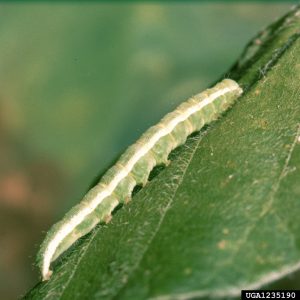
Features:
The Velvetbean Caterpillar (Anticarsia gemmatalis) is a notable pest in soybean fields, recognized for its voracious feeding habits and potential to cause significant defoliation. The larvae are green to black with yellowish stripes running the length of their bodies and are covered with fine velvety hairs, giving them their common name. They can grow up to 1.5 inches long. Adult moths are brown with a wingspan of about 1.5 inches and have distinctive markings on their wings.
Symptoms:
The symptoms of Velvetbean Caterpillar infestation include severe defoliation, where larvae consume large portions of the leaf tissue, leaving only the veins intact. This damage can lead to a significant reduction in photosynthetic capacity, stunted plant growth, and lower yield potential. In high infestations, larvae can strip plants of their foliage entirely, leading to weakened plants that are more susceptible to environmental stresses and secondary infections.
Management:
Effective control of Velvetbean Caterpillars involves a combination of regular monitoring, cultural practices, and chemical control when necessary. Regular scouting of soybean fields during the growing season is crucial for early detection of caterpillar activity and assessment of defoliation levels. Monitoring should focus on identifying larvae and quantifying the extent of leaf damage.
Cultural practices such as maintaining optimal plant density and ensuring good plant health through proper fertilization and irrigation can help mitigate the impact of Velvetbean Caterpillars. Early planting and crop rotation with non-host plants can also reduce the risk of severe infestations by disrupting the life cycle of the caterpillars.
Chemical control may be necessary when larval populations exceed economic thresholds. Insecticides can be effective in managing Velvetbean Caterpillar populations, but it is important to apply them based on scouting data and to use products with different modes of action to prevent resistance development. Biological insecticides containing Bacillus thuringiensis (Bt) are also effective and environmentally friendly options for controlling Velvetbean Caterpillars.
Solution:
To manage velvetbean caterpillar infestations effectively, a combined approach involving biological solutions can be highly effective. Products like Bt Thuricide offer a sustainable solution. Bt Thuricide is a biological insecticide derived from Bacillus thuringiensis that specifically targets caterpillar pests like velvetbean caterpillars by releasing toxins that disrupt their digestive systems, leading to their death. With a four-hour reentry interval, Bt Thuricide is safe for both farmers and the environment. By incorporating Bt Thuricide into an integrated pest management strategy, farmers can significantly reduce velvetbean caterpillar populations and protect their soybean crops from extensive damage. Regular application during the early stages of caterpillar infestation ensures optimal results, promoting healthier and more productive soybean fields.
Soybean Diseases
Phytophthora Root Rot (Phytophthora sojae)
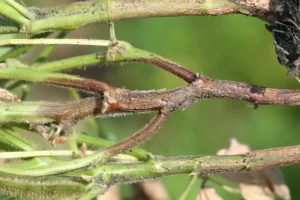
Features:
Phytophthora Root Rot (Phytophthora sojae) is a serious soil-borne disease that affects soybean plants, caused by the oomycete pathogen Phytophthora sojae. This pathogen thrives in wet, poorly drained soils and can infect soybean plants at any growth stage, causing significant yield losses. The disease is characterized by the decay of roots and stems, which impairs the plant’s ability to absorb water and nutrients.
Symptoms:
The symptoms of Phytophthora Root Rot include dark, water-soaked lesions on the roots and lower stems, which can extend up to the base of the plant. As the disease progresses, these lesions turn dark brown and the tissue becomes soft and decayed. Infected plants often exhibit wilting, yellowing of leaves, and stunted growth. Severe infections can lead to plant death, particularly in young seedlings, resulting in stand reduction and uneven field appearance. In advanced stages, the root system may be entirely rotted, leading to plant collapse.
Management:
Effective management of Phytophthora Root Rot involves a combination of resistant varieties, cultural practices, and proper field management. Planting soybean varieties that are resistant or tolerant to Phytophthora sojae is one of the most effective strategies for controlling this disease. Breeding efforts have led to the development of many resistant varieties that can significantly reduce disease impact. Improving soil drainage through practices such as tile drainage or raised beds can help reduce the wet conditions that favor disease development. Crop rotation with non-host crops like corn or small grains can also help manage disease pressure by breaking the life cycle of the pathogen.
Solution:
To manage Phytophthora Root Rot effectively, a combined approach involving biological solutions can be highly effective. Products like Trianum Shield offer a sustainable solution. Trianum Shield is a biological fungicide derived from the beneficial fungus Trichoderma harzianum, which specifically targets root rot pathogens like Phytophthora by colonizing the root system and outcompeting harmful fungi. It enhances plant health by improving root growth and increasing resistance to disease. With a short reentry interval, Trianum Shield is safe for both farmers and the environment. By incorporating Trianum Shield into an integrated disease management strategy, farmers can significantly reduce Phytophthora Root Rot incidences and protect their soybean crops from extensive damage. Regular application, especially during the early stages of crop development, ensures optimal results, promoting healthier and more productive soybean fields.
Rhizoctonia Root Rot (Rhizoctonia solani)
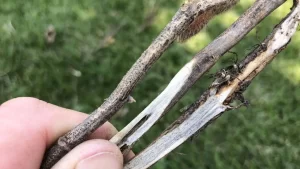
Features:
Rhizoctonia Root Rot (Rhizoctonia solani) is a common soil-borne fungal disease that affects soybean plants, among other crops. The pathogen is known for its ability to survive in the soil for extended periods and infect a wide range of hosts. It primarily attacks the roots and lower stems of soybean plants, leading to poor plant health and significant yield losses, particularly in fields with high soil moisture and poor drainage.
Symptoms:
The symptoms of Rhizoctonia Root Rot include reddish-brown lesions on the roots and lower stems, which may girdle the stem and inhibit the plant’s ability to transport water and nutrients. These lesions often have a sunken appearance and may expand to cover a large portion of the root system. Infected plants typically show stunted growth, wilting, and yellowing of leaves. In severe cases, the disease can lead to seedling damping-off, where young plants collapse and die shortly after emergence. Established plants may exhibit reduced vigor and productivity, leading to uneven stands and poor crop performance.
Management:
Effective management of Rhizoctonia Root Rot involves a combination of cultural practices, resistant varieties, and proper field management. Selecting and planting soybean varieties that exhibit resistance or tolerance to Rhizoctonia solani can help mitigate the impact of the disease. Improving soil drainage and avoiding over-irrigation are crucial to prevent the waterlogged conditions that favor the development of the pathogen. Practices such as crop rotation with non-host crops and the incorporation of organic matter can enhance soil health and reduce disease pressure.
Solution:
To manage Rhizoctonia Root Rot effectively, a combined approach involving biological solutions can be highly effective. Products like Trianum Shield offer a sustainable solution. Trianum Shield is a biological fungicide derived from the beneficial fungus Trichoderma harzianum, which specifically targets soil-borne pathogens like Rhizoctonia solani by colonizing the root system and outcompeting harmful fungi for space and nutrients. This beneficial fungus also induces plant resistance mechanisms, promoting overall plant health. With a safe reentry interval, Trianum Shield is safe for both farmers and the environment. By incorporating Trianum Shield into an integrated disease management strategy, farmers can significantly reduce Rhizoctonia Root Rot incidences and protect their soybean crops from extensive damage. Regular application at planting and during the early stages of crop growth ensures optimal results, promoting healthier and more resilient soybean fields.
Fusarium Root Rot
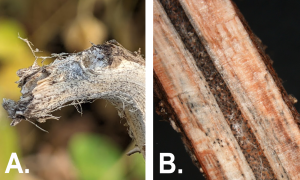
Features:
Fusarium Root Rot, caused by various species of Fusarium, is a soil-borne fungal disease that affects soybean plants, leading to significant yield losses. The pathogen thrives in both wet and dry soil conditions and can infect plants at any growth stage. It primarily targets the roots and lower stems, disrupting the plant’s ability to absorb water and nutrients.
Symptoms:
Symptoms of Fusarium Root Rot include reddish-brown to dark brown lesions on the roots and lower stems. Infected roots become discolored, brittle, and often show signs of decay. Plants with severe infections exhibit stunted growth, yellowing, and wilting of leaves. Root systems may be poorly developed with significant rot, leading to plant death in severe cases. Affected plants are often unevenly distributed across the field, creating patches of stunted and dying plants.
Management:
Effective management of Fusarium Root Rot involves using resistant varieties, improving soil health, and employing proper cultural practices. Selecting resistant or tolerant soybean varieties can reduce the impact of the disease. Crop rotation with non-host crops and the incorporation of organic matter can improve soil structure and health. Maintaining optimal soil moisture through proper irrigation practices and avoiding waterlogged conditions are crucial. Fungicide seed treatments can protect young seedlings in fields with a history of the disease. Regular monitoring and timely intervention are essential to manage Fusarium Root Rot effectively.
Solution:
To manage Fusarium Root Rot effectively, a combined approach involving biological solutions can be highly effective. Products like Trianum Shield offer a sustainable solution. Trianum Shield is a biological fungicide derived from Trichoderma harzianum, which specifically targets soil-borne pathogens like Fusarium by colonizing the root system and producing enzymes that degrade fungal cell walls, leading to their suppression. With a minimal reentry interval, Trianum Shield is safe for both farmers and the environment. By incorporating Trianum Shield into an integrated disease management strategy, farmers can significantly reduce Fusarium Root Rot incidences and protect their crops from extensive damage. Regular application during the early stages of disease development ensures optimal results, promoting healthier and more productive soybean fields.
Brown Stem Rot
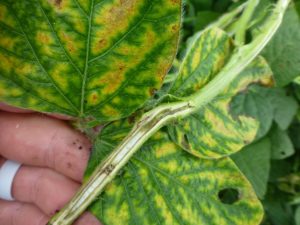
Features:
Brown Stem Rot (BSR), caused by the fungus Cadophora gregata, is a disease that affects soybean plants, leading to significant yield losses. The pathogen infects the stem, disrupting water and nutrient transport, and thrives in cooler, wetter climates.
Symptoms:
Symptoms of BSR include browning and rotting of the pith inside the stem, which can be observed by splitting the stem lengthwise. Infected plants may show interveinal chlorosis and necrosis on the leaves, similar to SDS. However, unlike SDS, the symptoms do not typically appear until late in the growing season. Affected plants often exhibit stunted growth, premature leaf drop, and reduced pod fill. The disease can lead to plant death in severe cases.
Management:
Effective management of BSR involves using resistant varieties, practicing crop rotation, and improving field drainage. Selecting soybean varieties resistant to BSR can significantly reduce the impact of the disease. Crop rotation with non-host crops such as corn and small grains can help break the disease cycle. Improving soil drainage and avoiding waterlogged conditions can also reduce disease severity. Regular field scouting and timely cultural practices are crucial for managing BSR effectively.
Solution:
To manage Brown Stem Rot infestations effectively, a combined approach involving biological solutions can be highly effective. Products containing Bacillus subtilis offer a sustainable solution. Bacillus subtilis is a beneficial bacterium that specifically targets soil-borne pathogens responsible for Brown Stem Rot in soybeans by producing antibiotics and enzymes that inhibit the growth of these harmful organisms, leading to their suppression. With a four-hour reentry interval, Bacillus subtilis products are safe for both farmers and the environment. By incorporating Bacillus subtilis into an integrated disease management strategy, farmers can significantly reduce Brown Stem Rot incidence and protect their crops from extensive damage. Regular application during the early stages of disease onset ensures optimal results, promoting healthier and more productive soybean fields.
Stem Canker
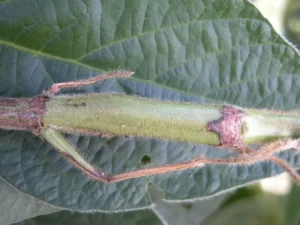
Features:
Stem Canker, caused by the fungus Diaporthe phaseolorum, is a significant disease affecting soybean plants, leading to yield losses. The pathogen infects the stem, causing cankers that disrupt water and nutrient transport.
Symptoms:
Symptoms of Stem Canker include reddish-brown lesions on the stems, which enlarge to form elongated, sunken cankers. These cankers can girdle the stem, leading to wilting, yellowing, and death of the plant above the infection site. Infected plants often exhibit stunted growth and reduced pod fill. The disease is more severe in fields with high moisture and dense plant canopies.
Management:
Effective management of Stem Canker involves using resistant varieties, practicing crop rotation, and ensuring good field sanitation. Planting soybean varieties resistant to Stem Canker can significantly reduce disease impact. Crop rotation with non-host crops can help break the disease cycle. Removing crop residues and managing field borders can reduce the inoculum level. Fungicide seed treatments and foliar applications during early growth stages can provide additional protection. Regular field scouting and timely intervention are essential for managing Stem Canker effectively.
Solution:
To manage Stem Canker in soybeans effectively, a combined approach involving biological solutions can be highly effective. Products like those containing Trichoderma harzianum or Bacillus subtilis offer sustainable solutions. Trichoderma harzianum is a beneficial fungus that combats pathogens by outcompeting them for space and nutrients, while Bacillus subtilis is a bacterium that produces antibiotics and enzymes to inhibit the growth of harmful fungi causing Stem Canker.
With their natural modes of action, both Trichoderma harzianum and Bacillus subtilis are safe for both farmers and the environment. By incorporating these biological agents into an integrated disease management strategy, farmers can significantly reduce the incidence of Stem Canker and protect their crops from extensive damage. Regular application, especially during the early stages of disease development, ensures optimal results, promoting healthier and more resilient soybean fields.
White Mold
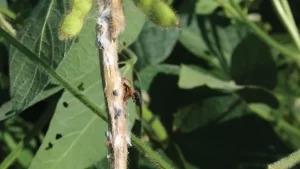
Features:
White Mold, caused by the fungus Sclerotinia sclerotiorum, is a significant disease affecting soybean plants, particularly in cool, wet conditions. The pathogen infects the stems, leaves, and pods, leading to substantial yield losses.
Symptoms:
Symptoms of White Mold include white, cottony fungal growth on stems, leaves, and pods. Infected areas develop hard, black sclerotia that can be found inside stems and pods. Plants may exhibit wilting, yellowing, and dieback above the infection site. The disease often appears in patches in the field, particularly in areas with dense canopies and poor air circulation.
Management:
Effective management of White Mold involves using resistant varieties, improving field drainage, and practicing crop rotation. Selecting soybean varieties with resistance to White Mold can reduce disease severity. Improving air circulation by managing plant density and row spacing can help prevent disease development. Crop rotation with non-host crops such as corn and small grains can disrupt the life cycle of the pathogen. Fungicide applications during flowering can provide additional protection. Regular field scouting and timely cultural practices are crucial for managing White Mold effectively.
Solution:
To manage white mold in soybean crops effectively, a combined approach involving biological solutions can be highly effective. Products like Metilo offer sustainable solutions. Metilo is a biological fungicide that utilizes beneficial fungi to combat pathogenic fungi responsible for white mold. By colonizing plant roots and producing antifungal compounds, Metilo inhibits the growth of white mold and enhances plant resistance. Metilo is safe for farmers and the environment, with minimal reentry intervals.
By incorporating Metilo into an integrated disease management strategy, farmers can significantly reduce white mold incidence and protect their soybean crops from extensive damage. Regular application, especially during the early stages of disease development or when environmental conditions favor mold growth, ensures optimal results, promoting healthier and more productive soybean fields.
Downy Mildew
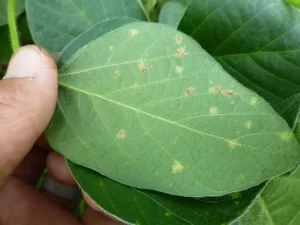
Features:
Downy Mildew, caused by the oomycete pathogen Peronospora manshurica, is a foliar disease that affects soybean plants, leading to reduced photosynthesis and yield losses. The pathogen thrives in cool, moist conditions and spreads via windborne spores.
Symptoms:
Symptoms of Downy Mildew include pale green to yellow spots on the upper leaf surface, with a corresponding white to grayish-purple mold growth on the underside of the leaves. Infected leaves may become chlorotic and eventually necrotic, leading to premature leaf drop. The disease can also affect pods and seeds, causing them to become discolored and shriveled.
Management:
Effective management of Downy Mildew involves using resistant varieties, improving air circulation, and practicing crop rotation. Planting resistant soybean varieties can significantly reduce disease impact. Improving air circulation through proper plant spacing and row orientation can help reduce humidity levels that favor the disease. Crop rotation with non-host crops such as corn can help break the disease cycle. Fungicide applications can provide additional protection during favorable conditions. Regular monitoring and timely intervention are essential for managing Downy Mildew effectively.
Solution:
To manage Downy Mildew in soybeans effectively, a combined approach involving biological solutions can be highly effective. Products like Trianum V offer sustainable solutions. Trianum V contains Trichoderma harzianum, a beneficial fungus that acts as a biological fungicide by colonizing plant surfaces and outcompeting the pathogens that cause Downy Mildew. Additionally, it produces compounds that inhibit fungal growth. With a four-hour reentry interval, Trianum V is safe for both farmers and the environment. By incorporating Trianum V into an integrated pest management strategy, farmers can significantly reduce Downy Mildew outbreaks and protect their crops from extensive damage. Regular application, particularly during the early stages of disease development, ensures optimal results, promoting healthier and more productive soybean fields.
Frogeye Leaf Spot
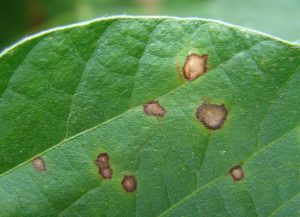
Features:
Frogeye Leaf Spot, caused by the fungus Cercospora sojina, is a foliar disease that affects soybean plants, leading to significant yield losses. The pathogen thrives in warm, humid conditions and spreads via wind and rain-splashed spores.
Symptoms:
Symptoms of Frogeye Leaf Spot include small, circular to irregular spots with light gray centers and dark brown to purple borders on the leaves. The spots can coalesce to form larger lesions, leading to extensive leaf blighting. Infected leaves may become chlorotic and necrotic, resulting in premature leaf drop. The disease can also affect stems and pods, causing similar lesions.
Management:
Effective management of Frogeye Leaf Spot involves using resistant varieties, practicing crop rotation, and applying fungicides. Selecting resistant soybean varieties can significantly reduce disease impact. Crop rotation with non-host crops such as corn can help break the disease cycle. Fungicide applications, particularly during the reproductive stages, can provide effective control. Regular field scouting and timely intervention are crucial for managing Frogeye Leaf Spot effectively.
Solution:
To manage Frogeye Leaf Spot in soybeans effectively, a combined approach involving biological solutions can be highly effective. Products containing Bacillus subtilis and Bacillus amyloliquefaciens offer sustainable solutions. These beneficial bacteria work by colonizing the leaf surface and producing antimicrobial compounds that inhibit the growth of the Frogeye Leaf Spot pathogen, Cercospora sojina. Additionally, they induce systemic resistance in plants, enhancing their natural defenses against infections. With a four-hour reentry interval, these biological treatments are safe for both farmers and the environment. By incorporating Bacillus subtilis and Bacillus amyloliquefaciens into an integrated disease management strategy, farmers can significantly reduce the incidence of Frogeye Leaf Spot and protect their soybean crops from extensive damage. Regular application during the early stages of disease development ensures optimal results, promoting healthier and more productive soybean fields.
Septoria Brown Spot
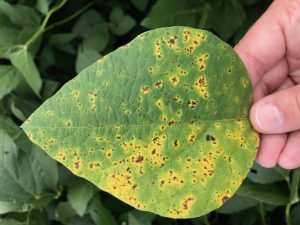
Features:
Septoria Brown Spot, caused by the fungus Septoria glycines, is a common foliar disease that affects soybean plants, leading to reduced photosynthesis and yield losses. The pathogen thrives in warm, wet conditions and spreads via rain-splashed spores.
Symptoms:
Symptoms of Septoria Brown Spot include small, angular brown spots on the lower leaves, which may coalesce to form larger areas of necrosis. Infected leaves may turn yellow and drop prematurely, leading to defoliation from the bottom of the plant upwards. Severe infections can result in significant leaf loss and reduced plant vigor.
Management:
Effective management of Septoria Brown Spot involves using resistant varieties, improving air circulation, and practicing crop rotation. Planting resistant soybean varieties can reduce disease severity. Improving air circulation through proper plant spacing and row orientation can help reduce humidity levels that favor the disease. Crop rotation with non-host crops such as corn can help break the disease cycle. Fungicide applications can provide additional protection, especially during periods of wet weather. Regular monitoring and timely cultural practices are essential for managing Septoria Brown Spot effectively.
Solution:
To manage Septoria Brown Spot effectively, a combined approach involving biological solutions can be highly effective. Products containing Bacillus subtilis and Bacillus amyloliquefaciens offer sustainable solutions. These beneficial bacteria act as biological fungicides by colonizing plant surfaces and producing antimicrobial compounds that inhibit the growth of Septoria glycines, the pathogen responsible for Septoria Brown Spot. With a short reentry interval, these biocontrol agents are safe for both farmers and the environment. By incorporating Bacillus subtilis and Bacillus amyloliquefaciens into an integrated disease management strategy, farmers can significantly reduce Septoria Brown Spot incidence and protect their soybean crops from extensive damage. Regular application during the early stages of disease development ensures optimal results, promoting healthier and more productive soybean fields.
Nutrition Management in Organic Soybeans
Nutrition management in organic soybean production is a critical aspect of achieving healthy growth and optimal yields. Organic practices emphasize the use of natural and sustainable inputs to nourish the soil and plants. This includes incorporating organic matter such as compost, manure, and cover crops to enhance soil fertility and structure. Regular soil testing is essential to identify nutrient deficiencies and adjust inputs accordingly. Nitrogen, a key nutrient for soybeans, can be supplied through legume cover crops, green manures, and approved organic fertilizers like blood meal or fish emulsion. Maintaining balanced levels of phosphorus and potassium is also crucial, achievable through rock phosphate and potassium sulfate applications. Additionally, crop rotation and intercropping with legumes can improve soil health and nutrient availability. By adhering to organic principles and practices, farmers can effectively manage nutrition in soybean crops, promoting vigorous growth and high-quality yields while sustaining the environment.
Solutions for Essential Nutrients
Nitrogen for Soybeans
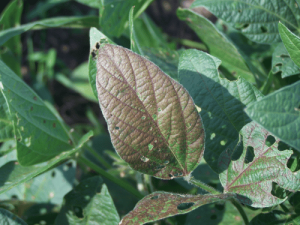 One of the most effective solutions for supplying nitrogen in organic soybean production is METILO. METILO provides an organic source of nitrogen, essential for promoting vigorous growth and healthy foliage in soybean plants. It aids in the breakdown of organic matter, releasing nitrogen in a form that plants can readily absorb. This enhancement of nitrogen availability supports robust plant development and boosts overall crop productivity, contributing to sustainable farming practices by minimizing the need for synthetic fertilizers.
One of the most effective solutions for supplying nitrogen in organic soybean production is METILO. METILO provides an organic source of nitrogen, essential for promoting vigorous growth and healthy foliage in soybean plants. It aids in the breakdown of organic matter, releasing nitrogen in a form that plants can readily absorb. This enhancement of nitrogen availability supports robust plant development and boosts overall crop productivity, contributing to sustainable farming practices by minimizing the need for synthetic fertilizers.
Phosphorus for Soybean
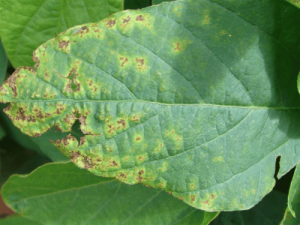 For phosphorus management, Cropium is an excellent solution. Cropium enhances phosphorus availability in the soil, which is vital for root development and energy transfer within the plant. By using Cropium, farmers can ensure their soybean crops receive the necessary phosphorus for optimal growth. This advanced agricultural product promotes efficient nutrient use, resulting in healthier plants and higher yields, while also reducing dependence on traditional phosphorus-based fertilizers.
For phosphorus management, Cropium is an excellent solution. Cropium enhances phosphorus availability in the soil, which is vital for root development and energy transfer within the plant. By using Cropium, farmers can ensure their soybean crops receive the necessary phosphorus for optimal growth. This advanced agricultural product promotes efficient nutrient use, resulting in healthier plants and higher yields, while also reducing dependence on traditional phosphorus-based fertilizers.
Potassium and Silicon Nutrients for Soybeans
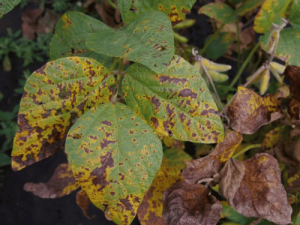 Bacillus mucilaginosus is a beneficial bacterium that solubilizes potassium and releases silicon in the soil, making these nutrients available to soybean plants. Potassium is crucial for overall plant health and disease resistance, while silicon strengthens plant tissues, enhancing their ability to withstand stress. By incorporating Bacillus mucilaginosus into their soil management practices, farmers can improve nutrient availability and support the resilience and vigor of their soybean crops.
Bacillus mucilaginosus is a beneficial bacterium that solubilizes potassium and releases silicon in the soil, making these nutrients available to soybean plants. Potassium is crucial for overall plant health and disease resistance, while silicon strengthens plant tissues, enhancing their ability to withstand stress. By incorporating Bacillus mucilaginosus into their soil management practices, farmers can improve nutrient availability and support the resilience and vigor of their soybean crops.
Soil Amendment and Growth Stimulation
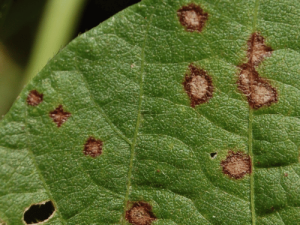 Soil Vigor is an excellent product for soil amendment and growth stimulation. It contains a blend of beneficial microorganisms that improve soil structure, enhance nutrient uptake, and stimulate plant growth. Using Soil Vigor ensures a healthy and fertile soil environment, promoting robust soybean growth. This biological approach to soil management fosters a dynamic and productive ecosystem, supporting long-term agricultural sustainability and reducing the reliance on chemical inputs.
Soil Vigor is an excellent product for soil amendment and growth stimulation. It contains a blend of beneficial microorganisms that improve soil structure, enhance nutrient uptake, and stimulate plant growth. Using Soil Vigor ensures a healthy and fertile soil environment, promoting robust soybean growth. This biological approach to soil management fosters a dynamic and productive ecosystem, supporting long-term agricultural sustainability and reducing the reliance on chemical inputs.
Integrated Pest Management (IPM) Practices for Soybean Growing
Integrated Pest Management (IPM) is a holistic approach to managing pests and diseases in soybean production, combining multiple strategies to achieve sustainable and effective control. IPM emphasizes the use of biological controls, cultural practices, resistant varieties, and judicious use of chemical interventions to minimize pest damage while preserving the environment. By integrating these methods, farmers can maintain healthy crops, reduce the reliance on chemical pesticides, and promote long-term agricultural sustainability.
Key IPM Practices for Soybean Growing:
- Biological Controls: Utilizing natural predators, parasitoids, and pathogens to control pest populations is a cornerstone of IPM. For example, introducing beneficial insects like ladybugs and lacewings can help manage aphid populations, while Beauveria bassiana and other microbial insecticides can target specific pests like soybean aphids without harming beneficial species.
- Cultural Practices: These include techniques such as crop rotation, intercropping, and the use of trap crops to disrupt pest life cycles and reduce their impact. Proper irrigation, sanitation, and maintaining healthy soil through organic amendments also contribute to a robust IPM strategy.
- Resistant Varieties: Planting soybean varieties that are genetically resistant to certain pests and diseases can significantly reduce the need for chemical treatments. Resistant varieties have been developed to withstand threats such as soybean cyst nematodes and soybean rust, enhancing crop resilience and yield.
- Monitoring and Scouting: Regular monitoring of pest and disease levels through field scouting and using tools like pheromone traps and remote sensing technology allows for early detection and timely intervention. This proactive approach helps in applying targeted treatments and preventing outbreaks.
- Chemical Controls: When necessary, the use of chemical pesticides is incorporated into IPM in a targeted and judicious manner. By rotating different classes of chemicals and applying them based on monitoring data, farmers can prevent the development of pest resistance and minimize environmental impact.
Conclusion
In conclusion, integrated pest management (IPM) practices for soybean growing are essential for maintaining crop health, maximizing yields, and promoting sustainable agriculture. Crop rotation plays a critical role in disrupting pest life cycles and improving soil fertility, while biological controls offer environmentally friendly solutions to manage pest populations. The use of resistant varieties enhances the plant’s natural defenses against pests and diseases, reducing the need for chemical interventions. By adopting these IPM practices, farmers can achieve a balanced and sustainable approach to pest management, ensuring the long-term productivity and health of their soybean crops.
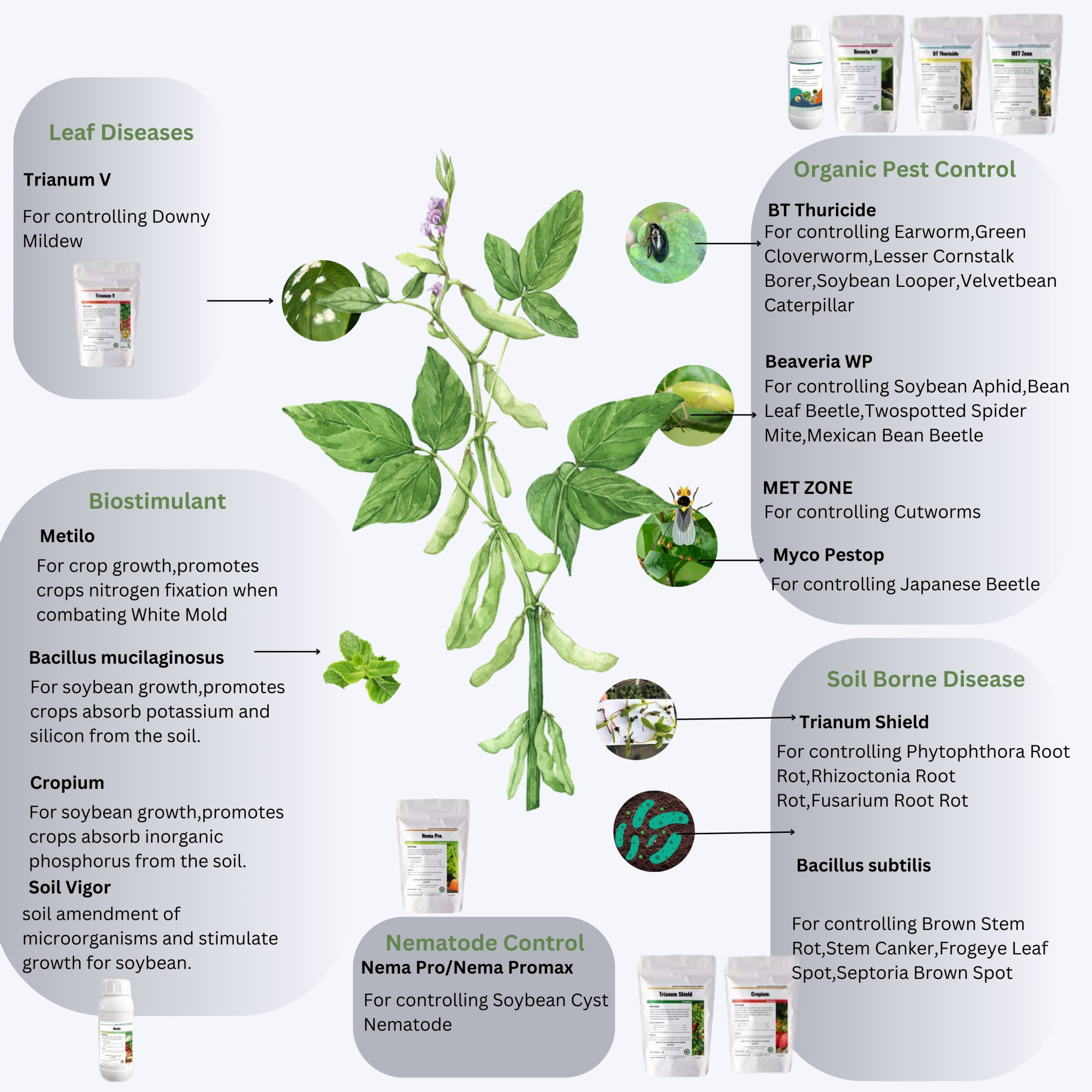
Next Page
Related Products
CONTACT US

Office 38/1502, No 660,Hanguang Rt., Changsha City, Hunan, China
































